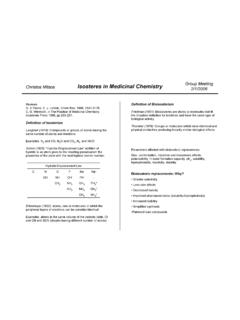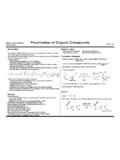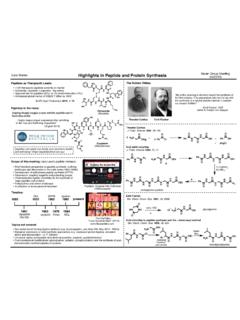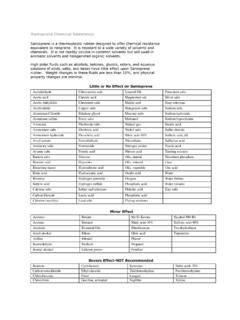Transcription of Cyclopentane Synthesis
1 Cyclopentane SynthesisDan O MalleyBaran Group MeetingGroup Meeting2/9/2005O'MalleyCyclopentane SynthesisStudents of organic chemistry are taught a number of reactions for the Synthesis of cyclohexanes at a very early stage of their careers. Techniques for the creation of cyclopentanes,however, are generally taught at a much later stage and are rarely given the same detailed may be the result of the fact that there are no equivalents of reactions such as the Diels-Alder andRobinson Annulation in terms of generality, extent of use, and historical importance. This may, in turn,be caused by the fact that the Cyclopentane is an inherintly "umpoled" functionality, as illustrated situation is further exacerbated by the general lack of cheaply available Cyclopentane compoundsin the chiral pool; wheras a number of cyclohexane terpenes are readily available for elaboration, thereare no analogous cylcopentane natural products.
2 Cyclopentanes are however, present in manymolecules which represent unanswered challenges at the forefront of organic COOOOHMeHMeMeHMeHPseudolarolide QAlthough there may not be as many well-known "general" methods for the construction of cyclopentanesas there are for 3,4, or 6 membered rings, there are in fact an enormous number of methods that havebeen applied to their Synthesis , so this review is by no means comprehensive. As cyclopentadienes, cyclopentadienes, and fulvenes are generally highly unstable and are generally synthesized to be used immediately in a reaction rather than as a target in and of themselves, their Synthesis is not covered , this review focuses on "active" methods of Cyclopentane Synthesis , wherein the ring is being createddirectly, rather than being formed from the tether of another ring formation.
3 For example an intramolecularDiels-Alder reaction could create a Cyclopentane as shown below, but this would be a "passive" formationof the cyclopenane and therefore outside the scope of this within these restrictions, there are still a prohibitively large number of Cyclopentane syntheses. The ones included here have been selected base upon their novelty, effectiveness, usefulness, andease of presentation is broken down into the following catagories. Some reactions either fit more than onecategory or do not fit easily into any of them. Efforts have been made to place all such reactions in the most appropriate General InformationII. Ionic ReactionsIII. Metal Mediated ReactionsIV. Radical ReactionsV. Pericyclic and Pseudo-pericyclic ReactionsVI. Ring Expansion and Contraction ReactionsI.
4 General InformationBaldwin's rulesBaldwin has divided ring closure reactions into those that are "favored" and those that are "disfavored".Those that are disfavored are not always impossible, but are frequently much more difficult to classifications are based upon groups connected by a chain of methylene groups. Replacementof these groups with atoms other than carbon, changing their hybridization, and placing substitution uponthem will alter the readiness of ring rules relevant to the closure of cyclopentanes and the competing reactions are as follows:five-exo-tet is favoredfive-exo-trig is favored; four-endo-trig is disfavoredfive-endo-trig is disfavored; six-exo-trig is favoredfive-exo-dig is favored; six-endo-dig is favoredfive-endo-dig is favored; four-exo-digo is disfavoredSeperate rules for enolate reactions have been created.
5 These are explained is disfavoredfive-enolexo-exo-tet is favoredfive-enolexo-exo-trig is favoredfive-enolendo-exo-trig is disfavoredThe Thorpe-Ingold EffectAs noted above, the nature of the substituents on the chain which is to form a ring affects the rate of ringclosure. Transannular interactions of CH2 groups contribute to ring strain, so replacement of one or moremethylene groups with heteroatoms or sp2 carbons can eliminate some transannular strain. Although this effect is most pronounced in the closure of medium-sized rings, many methods of five membered ring formation, particularly passive ones, function more effectively when creating tetrahydrofurans or pyrrolidenes than when generating cyclopentanes. Thus, passive methods for the formation of these rings are not always effective for the Synthesis of similar effect is the Thorpe-Ingold or gem-dimethyl effect.
6 The placement of quaternary carbon at the center of chain can substantially enhance its rate of ring formation. This occurrs for several reasons. The quaternary carbon has a smaller C-C-C bond angle, so a smaller reduction in this angle is necessary to effect ring formation. Also, the increased number of gauche interactions destablilizes open form more than the closed ring, further reducing the energy gap. From an entropic standpoint, the quaternary carbon greatly reduces the flexibility of the open chain and thus its entropy but has little effect upon the entropy of the ring. As a result, many annulation procedures are tested upon chains bearing a quaternary center. Readers are warned that reaction rates and yields may decrease if this carbon is replaced with a methylene Meeting2/9/2005O'MalleyCyclopentane SynthesisII.
7 Ionic ReactionsMany traditional ionic reactions, such as aldol condensations and enolate alkylations, can be appliedto the Synthesis of Cyclopentane derivatives. There are also a number of special protocols for the sequential for the addition of the necessary appendages to common functional groups followed byimmediate ring closure, often in a single and coworkers used a Michael addition to establish a Cyclopentane ring in their Synthesis of (-)-Picrotoxinin and (+)-Coriamyrtin. (JACS, 1984, 106, 4547-4552)OOOHCO2 MeO1. aq. AcOH2. Et2NH98%OHOOHCO2 MeOOOOOHOOOHOO picrotoxinincoriamyrtinMcMurray has developed a simple procedure for generating a specific aldol product of a 1,4-diketoneby generating it from an acetoxy cyclopropanone. Tet. Lett., 27, 2575-2578, +OAcOOAcCu(acac)55%NaOH, MeOHreflux 1h.
8 , 85%OOOEtCHN2 OOAcCu(acac), 75 C35%EtOOAc1. 4% NaOH/MeOHreflux, 2 h, 90%2. Lindlar cat., H2, 95%Ocis-jasmoneKoreeda and Mislankar have developed an annulation procedure using a dianion and a b-iodoaldehyde and applied it to a Synthesis of racemic coriolin. JACS, 1983, ( eq);IHO;-78 C, 48 h;MOMCl, 65%OOtBuHHMOMO1. MeLi; H+ 91% SMe2, 92%OHHMOMOOO25% aq. HCl, THFOHHHOOHHHHHOOOOC oriolinIsobutenyl groups can be used as a surrogate for a CH2 COCH3 group, enabling a three-step annulationfrom a ketone to a cyclopentenone. McMurry used this approach in his Synthesis of Aphidicolin. JACS, 1979, 101, ;I89%cat. OsO4, NaIO486%NaH, 95%A. Enolate ReactionsGroup Meeting2/9/2005O'MalleyCyclopentane SynthesisBoger and Corey have developed a procedure to use the benzothiazole group as a masked aldehyde,giving access to fused and spiro cyclopentanes.
9 Tet. Lett.,1979, 5-8, 9-12, 'ONSLi+RR'OHBTBtP2O5/MsOH orTsOH, C6H6 reflux orMeOOCN-SO2N+Et3 Provides alternative to enals, which are poor Michael , -78 C, 2h;dil. HCl, 93%BTOCHOOOTMSOTf;NaBH4 -78 C;AgNO3, pH 788%NaOH, EtOH55 C, 86%BTBTCHOOMeLi, -78 C;Br96%, > 98% ds, rtTMSOTf;NaBH4, -78 C;TMSOTf; aq. K2CO3, 74% eq HgSO4;H2SO4 CHOONaOH, EtOH78% (two steps)B. Grignard-Type ReactionsCanonne and Belanger developed a simple and direct method to spirocyclopentanes using bis-Grignardreagents. J. Chem. Soc. Chem. Comm. 1980, 125, (CH2)4 MgBr;10% HCl, 63-86%OOR=Yield(CH2)2(CH2)3636966758680 The use of 3-halo organocuprates or grignard reagents for a Michael addition followed by an enolatealkylation has been used several times for the construction of and Gavai used a two step procedure in their Synthesis of racemic oplopanones.
10 J. Org. , 55, stratagies have been developed which usethe Saegusa oxidation instead of SMe2, BF3 OEt2, -78 C 70%HOAnhydrooplopanoneHKH92%Paquette used a similar procedure in his Synthesis of (+)-Ceroplastol. J. Am. Chem. Soc. 1993, 115, + 5%epiKH90%Fleming has developed an efficient multicomponent version using chelation control. Angew. Chem. Int. Ed. 2004, 43, ;ClMgClHCNiPrHO58%High diastereoselectivity is obtained when the grignard includes an alkyl group. JOC, 1987, 52, +BrMgMgBrR'HORR70-80%, 80-95% dsGroup Meeting2/9/2005O'MalleyCyclopentane SynthesisSeveral methods based on the conjugate addition of homoenolates to alkenes and alkynes followed by condensation of the resulting enolate have been developed. Talbiersky has developed a methodusing 3-aminoacrylates. Angew.












